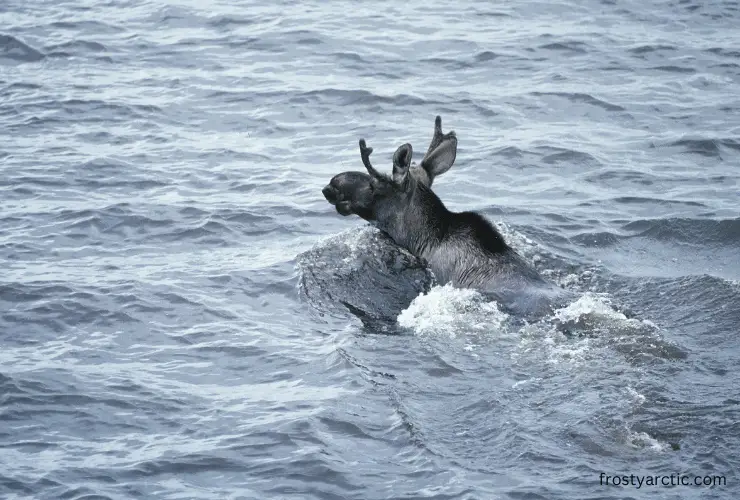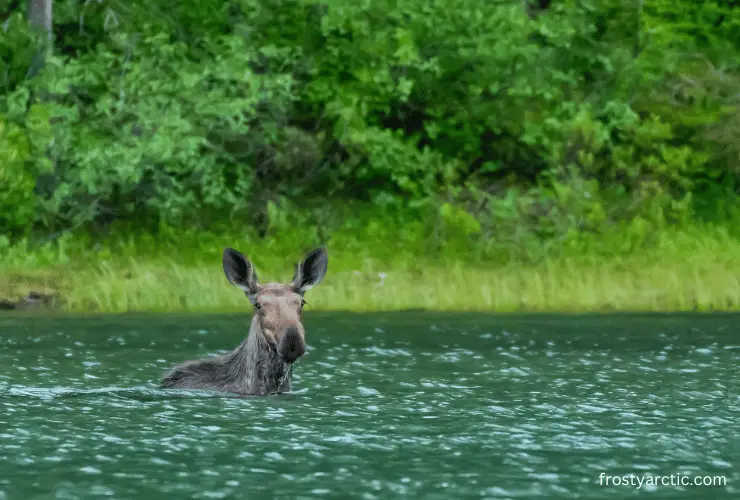Yes, moose can swim. In fact, they are known for swimming at incredibly high speeds of 6 miles per hour for 2 hours. Moose are equipped with a fur coat with hollow hairs, making them highly buoyant. Moose have been observed to dive underwater in search of food.
Did you know that moose have often been spotted in ponds and lakes to cool off in summer? Interesting, right? This article investigates the swimming behavior of moose.
Can Moose Swim? How Fast Can a Moose Swim?
Moose are the largest members of the deer family. Despite their massive body size and awkward structure, these animals can swim at an average speed of 6 miles per hour. ~ Alaska Department of Fish and Game
Six miles per hour is quite a fast speed, especially considering that humans swim only at 2 miles per hour.
Moose have often been observed near ponds and lakes, especially in the summer season. The below video provides evidence about whether moose can swim.
Their habitat ranges from freshwater marshes and river valleys to willow thickets and even coniferous forests. This evidence also suggests that moose prefer to stay near the water in summer.
How Long Can Moose Swim?
If swimming at a speed of 6 miles per hour, moose can swim for a distance of 20 km, i.e., cover 12.4 miles. At this speed, moose can swim for 2 hours without stopping for rest.
Research also suggests that these animals can submerge completely underwater for approximately 30 seconds before returning to the surface. ~ National Geographic
How Deep Can Moose Swim? Can Moose Dive 20 feet Into Water?
Moose are known to hold their breath for about 60 seconds when under stress. Plus, their massive size and body weight helps them to dive underwater to a depth of 6 meters or 20 feet underwater.
These animals prefer to eat aquatic plants and animals in summer, so they can even dive to the bottom of lakes and deep ponds to search for food.

However, most of the time, moose prefer to dive in shallow waters because the plants and animals available have a higher nutritional value.
Did you know? Moose consume about 55 pounds of aquatic plants in a day, but because they live in the Northern regions, these animals have adapted to eating aquatic plants to fulfill their nutritional requirements. ~ CBC.ca
Why Do Moose Swim?
Since moose love the water so much and are often seen near water bodies in the summer, swimming must serve a special purpose in their survival. Let’s find out why moose swim:
1. Food:
In the winter, the food supply is usually scarce. As a result, moose lose nearly 30% of their body weight in this season.
So, as soon as the ice melts, moose dive into the water in search of aquatic plants and animals rich in nutrients to fulfill their nutritional requirements.
Moose live in places where the winter season is much longer than the summer season. Hence, moose resort to looking for food underwater.
Plus, moose require energy during the mating season and while growing antlers. So, swimming plays a key role in foraging for food.
2. Cool Off in Summer:
Moose are better adapted to surviving the cold than the short summer season. Because of their thick fur coat, they are vulnerable to overheating, which stresses them out in summer.
So, to cool off and maintain their body temperature, moose spend a lot of time cooling off in the water.
Did you know? Even temperatures as low as 60 Fahrenheit can stress moose out!
3. Shelter from Predators:
Moose often seek shelter from predators such as mountain lions and wolves underwater.
Moose can easily outrun their local predators in the water, making it one of the safest hideouts for these animals in summer.
Whenever moose are faced with predators, they run to the water where other predators don’t stand a chance!
4. Improve Health:
Moose have very long and thin legs paired with heavy bodies. These animals can run at fast speeds of nearly 35 miles per hour.
This puts a lot of pressure on their legs, raising the chances of moose getting arthritis and osteoporosis.
Simply standing in water helps moose alleviate the stress and pressure from their legs. Swimming prolongs their life by taking off the pressure from their bones and joints.
5. Removes Ticks and Bugs:
Moose are susceptible to suffering from tick infestations. In summer, they are highly vulnerable to being infested with bugs and ticks.
Swimming allows these animals to wash such parasites from their bodies, improving their overall health.
Can Moose Breathe Underwater?
Although moose are exceptional divers and can stay underwater for about 30 seconds, they cannot breathe underwater.

When moose dive, they fill their lungs with air to keep them oxygenated underwater for approximately a minute.
Mooses’ nostrils help them stay underwater for prolonged periods. Their nostrils are like valves that prevent water from entering their nose. ~ Cambridge.org
Plus, their respiration rate also falls when they dive, helping them stay submerged for longer.
Biological Adaptations That Help Moose Swim
Several biological adaptations enable moose to stay underwater, for example:
1. Fur:
Moose have hollow fur hair, which doesn’t just keep them warm but also helps them float in water, increasing the animal’s buoyancy. Air trapped inside the fur allows them to float on water.
Fur also functions as a life-jacket, insulating moose inside the water.
Did you know? When underwater, sharks are one of the biggest threats to moose. However, evidence suggests that sharks might choke on moose skin and fur because of their thickness. ~ TheWorld.org
2. Hooves and Strong Legs:
Moose are known for their long, slender legs and hooved feet, which help them run at fast speeds.
These features also allow it to swim for long distances and dive underwater in search of vegetation high in nutritional value. Their hooves act like paddles, allowing moose to swim at great speeds.
3. Valve-like Nostrils:
Moose are equipped with flexible, valve-like nostrils, which help them keep the water out when underwater. The nostrils close when the moose dives, preventing water from filling up the lungs and suffocating the animal.
4. Bulbous Nose:
Moose don’t necessarily need to come to the surface after foraging aquatic plants in the sea. This is because of their bulbous nose which allows them to chew and swallow underwater.
How Do Moose Eat Underwater?
Thanks to their bulbous nose, moose can easily chew and swallow aquatic plants underwater.
However, moose like to bring these plants to the surface to eat them. Once finished, they dive underwater again, in search of another mouthful.
Moose suck the plants into their mouth, then come to the surface to finish eating their foraged aquatic plants.
Can Baby Moose Swim?
Moose are adept swimmers, and so are their young. Research suggests that baby moose can swim just a few hours after birth.
Female moose often seek the shelter of lakes and water bodies to protect their young from predator attacks. As explained earlier, local predators like wolves and lions don’t stand a chance against moose if they are in the water.

Moose have often been observed gliding across the surface of the water with their young in ponds and lakes.
Moose offspring learn to swim so early on in their lives that they can benefit from the nutritious aquatic plants underwater. ~ PBS.org
FAQs:
What is the deepest dive by a mammal?
Cuvier’s beaked whales are the deepest diving mammals with a dive depth of 9,874 feet (2,992 m).
Do Moose Have Any Predators?
Yes, moose have predators, including black and grizzly bears, wolves, and even mountain lions.
Are Moose Safe from Predators Underwater?
Moose often use the water to hide from land predators such as lions and wolves. However, moose are often attacked by killer sharks underwater.
Can you shoot a moose in the water?
Yes, you can shoot moose in water, but you must ensure it is safe and doable before you fire.
Conclusion
Moose are bulky-sized, but that doesn’t mean they are not good swimmers or runners. These animals can swim at fast speeds while their maximum running speed is said to be 35 miles per hour. Plus, they are exceptional divers too!
I hope this article helped clear your doubts about whether moose can swim and helped explain their diving behavior in detail!


